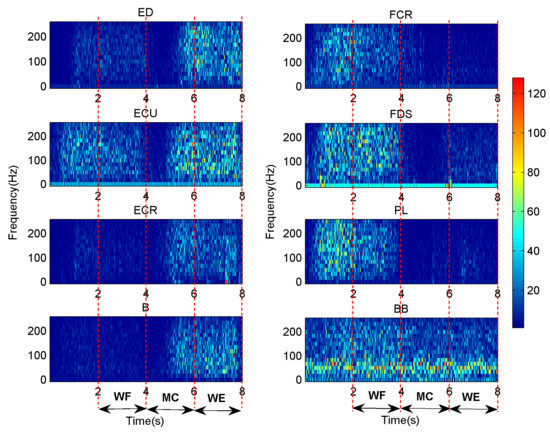


Ping Xie, Qingya Chang, Yuanyuan Zhang*, Xiaojiao Dong, Jinxu Yu, Xiaoling Chen*
Muscle synergy analysis is a kind of modularized decomposition of muscles during exercise controlled by the central nervous system (CNS). It can not only extract the synergistic muscles in exercise, but also obtain the activation states of muscles to reflect the coordination and control relationship between muscles. However, previous studies have mainly focused on the time-domain synergy without considering the frequency-specific characteristics within synergy structures. Therefore, this study proposes a novel method, named time-frequency non-negative matrix factorization (TF-NMF), to explore the time-varying regularity of muscle synergy characteristics of multi-channel surface electromyogram (sEMG) signals at different frequency bands. In this method, the wavelet packet transform (WPT) is used to transform the time-scale signals into time-frequency dimension. Then, the NMF method is calculated in each time-frequency window to extract the synergy modules. Finally, this method is used to analyze the sEMG signals recorded from 8 muscles during the conversion between wrist flexion (WF stage) and wrist extension (WE stage) movements in 12 healthy people. The experimental results show that the number of synergy modules in wrist flexion transmission to wrist extension (Motion Conversion, MC stage) is more than that in the WF stage and WE stage. Furthermore, the number of flexor and extensor muscle synergies in the frequency band of 0–125 Hz during the MC stage is more than that in the frequency band of 125–250 Hz. Further analysis shows that the flexion muscle synergies mostly exist in the frequency band of 140.625–156.25 Hz during the WF stage, and the extension muscle synergies appear in the frequency band of 125–156.25 Hz during the WE stage. These results can help to better understand the time-frequency features of muscle synergy, and expand study perspective related to motor control in nervous system.
肌肉协同分析是在中枢神经系统(CNS)控制下对运动中肌肉的一种模块化分解。它不仅能提取运动中具有协同作用的肌肉,还能获得肌肉的激活状态,反映肌肉之间的协调控制关系。然而,以往的研究主要关注时域协同,而没有考虑协同结构内部的频率特性。因此,本研究提出了一种名为时频非负矩阵因式分解(TF-NMF)的新方法,以探索多通道表面肌电图(sEMG)信号在不同频段上肌肉协同特征的时变规律性。该方法采用小波包变换(WPT)将时间尺度信号转换为时频维度。然后,在每个时频窗口中计算 NMF 方法,以提取协同模块。最后,该方法被用于分析 12 名健康人在手腕屈曲(WF 阶段)和手腕伸展(WE 阶段)动作转换过程中记录的 8 块肌肉的 sEMG 信号。实验结果表明,在腕关节屈曲向腕关节伸展的传递过程中(运动转换,MC 阶段),协同模块的数量多于 WF 阶段和 WE 阶段。此外,在 MC 阶段,0-125 Hz 频段的屈肌和伸肌协同作用数量多于 125-250 Hz 频段。进一步分析表明,在 WF 阶段,屈肌协同作用主要存在于 140.625-156.25 Hz 频段,而在 WE 阶段,伸肌协同作用出现在 125-156.25 Hz 频段。这些结果有助于更好地理解肌肉协同作用的时频特征,并拓展与神经系统运动控制相关的研究视角。